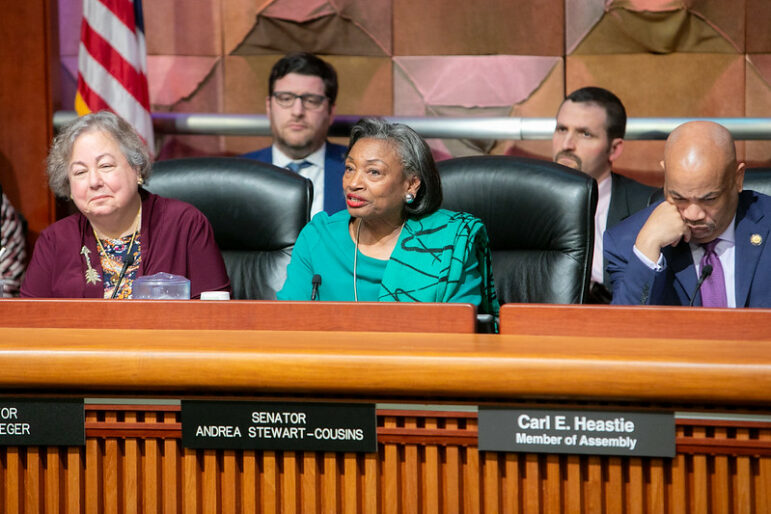“Not only are such increases necessary to secure investments in badly needed and widely desired public goods like education, health care, and housing—the costs of which are likely the driving factor behind the worrisome out-migration of working and middle class New Yorkers.”

NYS Senate Media Services
Both the State Senate and Assembly’s one house budget proposals included a push to increase revenues from top earners and businesses.There’s been a smart and sensible proposal in the state budget that will address the need for tax reforms to increase revenues from top earners and businesses. There are also proposals that will expand credits to workers and families with low incomes.
Gov. Kathy Hochul vowed no new taxes, but, unexpectedly, the Assembly and Senate agreed to two temporary (until 2027) tax provisions in their respective “one-house” budgets. The modest proposals include a half percentage point increase in personal income taxes for earnings over $5 million and in corporate income taxes for profits over the same threshold. Together these would generate a projected $2.2 billion in revenues in the first year alone.
These proposals come at a time when the state should be taking stock of where it has been, considering especially the impact of the pandemic on the state, and where it is headed, with a rosier economic outlook than expected. Inflation is declining, fear of a recession has subsided, and projected revenues are higher than anticipated. But the state looks very different than it did before the pandemic, and those differences are why additional tax revenue is justified.
Although New York typically leads all states in its level of inequality between rich and poor, it was one of only eight states to witness a statistically significant increase in inequality from 2021 to 2022 (the last full year of income data), according to the Census Bureau.
One hint as to why that is can be gleaned from trends in New York City. An analysis by the Center for New York City Affairs shows that inequality was stable in the years leading up to the pandemic and then increased significantly during the pandemic. By one measure, which undercounts volatile income from investments (such as realized capital gains), the share of income going to the top 1 percent rose from 29 to 32 percent between 2019 and 2022. By another measure, a whopping 85 percent of the income generated in the city from 2019 to 2021 accrued to the less than 3,000 households making $10 million dollars or more.
Meanwhile, New York state’s median household income is not the highest among states; it is not even in the top 10 (14 states have higher median incomes, including California and our neighbor, Connecticut). New York City also has lower median household income, and lower minimum wages, than eight other major cities. Poverty increased for both New York State and New York City between 2019 and 2022 after having fallen during the 2010s. Blacks and Latinx individuals are disproportionately affected by these trends.
In short, it is not the case, as is often said, that New York has high inequality because everyone does well here and the affluent just do even better.
These disparities are why high earners provide such a large share of tax revenues from income in the state—currently, the top 1 percent of taxpayers contribute about 40 percent of New York state tax revenues. In other words, if earnings were not so stacked in favor of the well off, the well off would be responsible for less of the tax burden.
Having said that, there is room to achieve more and generate needed revenue with the Assembly and Senate’s proposed tax increases on earnings and corporate profits above $5 million; and it is the right and popular thing to do.
First, the need is there because state spending has steadily declined over the past decade as a percent of state GDP, from 6.8 percent on average per year from 2000-2011 to the current 5.8 percent, which is a full $22 billion short of what spending would be if it matched the 6.8 rate of the 2000s. The need to (modestly) raise taxes at this time is justified by the fact that, despite needs, the state has been divesting in its people over the past decade.
Second, although New York’s tax rates for millionaires are high, they are far from the highest in the land. New York’s top marginal tax rate was raised in 2021 from 8.82 percent to 10.9 percent, but that rate applies only to incomes over $25 million, or .04 percent of taxpayers. By contrast, California has a much lower threshold and a higher top rate: 13.3 percent for incomes over $1 million (single filers). The current New York state legislative proposals are offering lower rates for much higher incomes—a rate increase from 10.3 to 10.8 percent for incomes over $5 million.
Lastly, it has taken a long time for politicians to catch up with public opinion, but they are finally realizing that Americans are supportive of increased taxes on the rich. Not only are such increases necessary to secure investments in badly needed and widely desired public goods like education, health care, and housing—the costs of which are likely the driving factor behind the worrisome out-migration of working and middle class New Yorkers. But tax increases on the rich are considered fair by working Americans, who see them as one of the only ways to reap their fair share of economic growth.
Leslie McCall is a presidential professor of sociology and political science and associate director for the Stone Center on Socio-Economic Inequality at The Graduate Center/CUNY.








